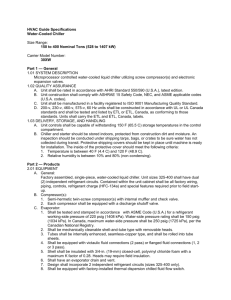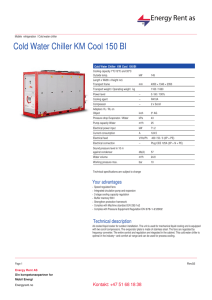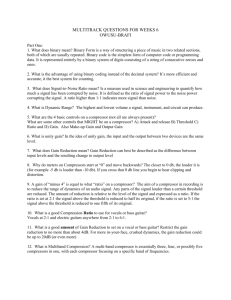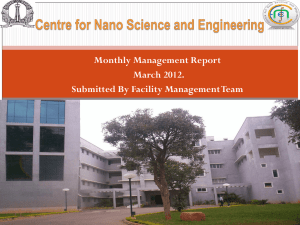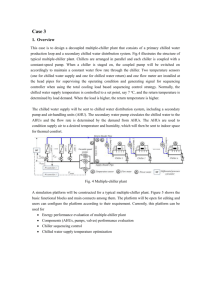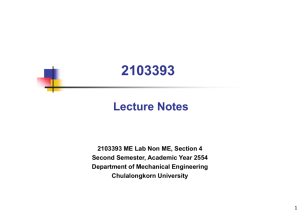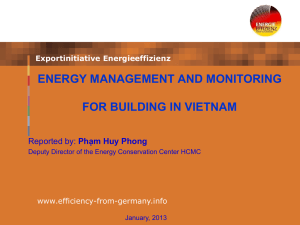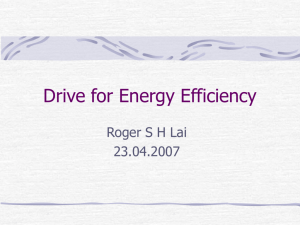30MPA,MPW Guide Specifications, 15 to 71 Nominal Tons (53 to
advertisement
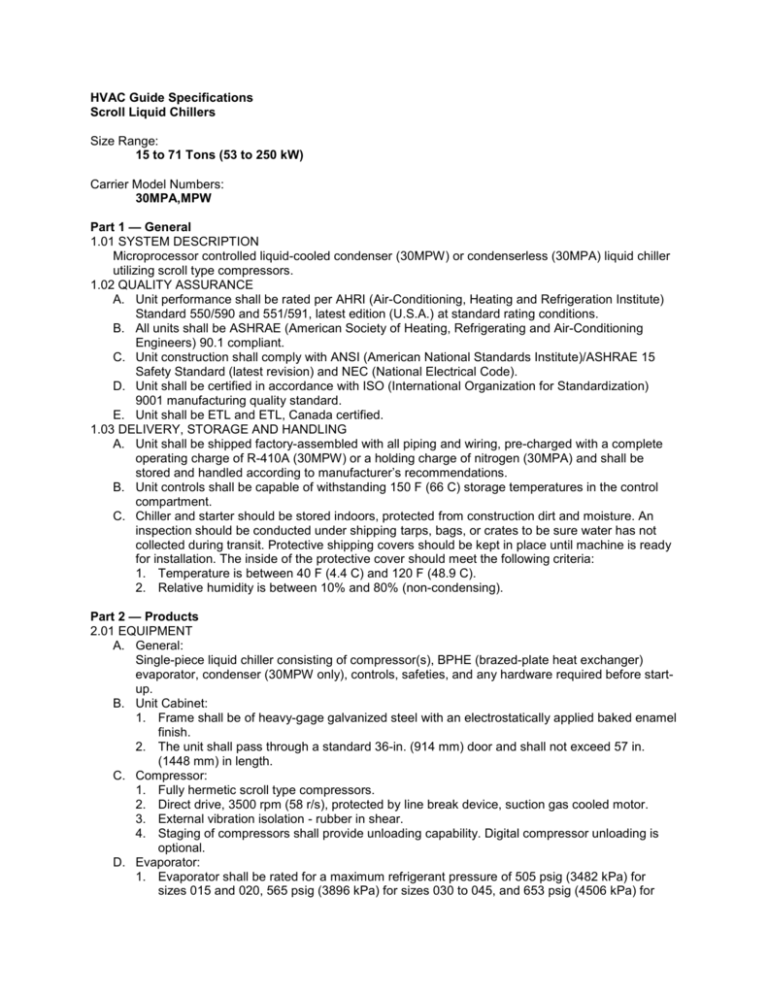
HVAC Guide Specifications Scroll Liquid Chillers Size Range: 15 to 71 Tons (53 to 250 kW) Carrier Model Numbers: 30MPA,MPW Part 1 — General 1.01 SYSTEM DESCRIPTION Microprocessor controlled liquid-cooled condenser (30MPW) or condenserless (30MPA) liquid chiller utilizing scroll type compressors. 1.02 QUALITY ASSURANCE A. Unit performance shall be rated per AHRI (Air-Conditioning, Heating and Refrigeration Institute) Standard 550/590 and 551/591, latest edition (U.S.A.) at standard rating conditions. B. All units shall be ASHRAE (American Society of Heating, Refrigerating and Air-Conditioning Engineers) 90.1 compliant. C. Unit construction shall comply with ANSI (American National Standards Institute)/ASHRAE 15 Safety Standard (latest revision) and NEC (National Electrical Code). D. Unit shall be certified in accordance with ISO (International Organization for Standardization) 9001 manufacturing quality standard. E. Unit shall be ETL and ETL, Canada certified. 1.03 DELIVERY, STORAGE AND HANDLING A. Unit shall be shipped factory-assembled with all piping and wiring, pre-charged with a complete operating charge of R-410A (30MPW) or a holding charge of nitrogen (30MPA) and shall be stored and handled according to manufacturer’s recommendations. B. Unit controls shall be capable of withstanding 150 F (66 C) storage temperatures in the control compartment. C. Chiller and starter should be stored indoors, protected from construction dirt and moisture. An inspection should be conducted under shipping tarps, bags, or crates to be sure water has not collected during transit. Protective shipping covers should be kept in place until machine is ready for installation. The inside of the protective cover should meet the following criteria: 1. Temperature is between 40 F (4.4 C) and 120 F (48.9 C). 2. Relative humidity is between 10% and 80% (non-condensing). Part 2 — Products 2.01 EQUIPMENT A. General: Single-piece liquid chiller consisting of compressor(s), BPHE (brazed-plate heat exchanger) evaporator, condenser (30MPW only), controls, safeties, and any hardware required before startup. B. Unit Cabinet: 1. Frame shall be of heavy-gage galvanized steel with an electrostatically applied baked enamel finish. 2. The unit shall pass through a standard 36-in. (914 mm) door and shall not exceed 57 in. (1448 mm) in length. C. Compressor: 1. Fully hermetic scroll type compressors. 2. Direct drive, 3500 rpm (58 r/s), protected by line break device, suction gas cooled motor. 3. External vibration isolation - rubber in shear. 4. Staging of compressors shall provide unloading capability. Digital compressor unloading is optional. D. Evaporator: 1. Evaporator shall be rated for a maximum refrigerant pressure of 505 psig (3482 kPa) for sizes 015 and 020, 565 psig (3896 kPa) for sizes 030 to 045, and 653 psig (4506 kPa) for sizes 050 to 071, and shall be tested for a maximum water-side pressure of 300 psig (2068 kPa). 2. Shall be single-pass, ANSI type 316 stainless steel, brazed plate construction. 3. Shall be insulated with 3/4-in. (19 mm) closed-cell, polyvinyl-chloride foam with a maximum K factor of 0.28. 4. Unit shall be provided with a factory-installed flow switch. 5. Unit shall be provided with entering and leaving chilled water temperature sensors and water pressure access port. 6. A strainer with a minimum of 40 mesh must be installed within 10 ft (3 m) of the heat exchanger fluid inlet to prevent debris from clogging the heat exchanger. This strainer shall be required and shall be available as an accessory. E. Brazed-Plate Condenser: 1. Condenser shall be rated for a maximum refrigerant pressure of 505 psig (3482 kPa) for sizes 015 and 020, 565 psig (3896 kPa) for sizes 030 to 045, and 653 psig (4506 kPa) for sizes 050 to 071, and shall be tested for a maximum water-side pressure of 300 psig (2068 kPa). 2. Single-pass, liquid-cooled, ANSI type 316, stainless-steel brazed-plate construction that shall provide positive subcooling of liquid refrigerant. 3. Unit shall be equipped with Victaulic water connections. 4. A strainer with a minimum of 40 mesh must be installed within 10 ft (3 m) of heat exchanger fluid inlet to prevent debris from clogging the heat exchanger. This strainer shall be required and shall be available as an accessory. F. Refrigerant Components: 1. Each chiller shall contain the following: sight glass; filter drier; liquid line solenoid valve (30MPA); liquid line isolation valve (30MPA); expansion valve; and charging port. 2. Expansion valve (TXV [thermostatic expansion valve] unit sizes 015-045, EXV [electronic expansion valve] unit sizes 050-071) shall be located within 12 in. of the evaporator with no bend between expansion valve and evaporator in accordance with evaporator manufacturer recommendation. G. Controls, Safeties and Diagnostics: 1. Controls: a. Unit controls shall include the following minimum components: 1) Microprocessor. 2) Power and control circuit terminal blocks. 3) ON/OFF control switch. 4) Thermistor is installed to measure evaporator entering and leaving fluid temperatures. 5) Terminal block for temporary and/or permanent interface to the Carrier Comfort Network® or similar building system control. b. Microprocessor with non-volatile memory. Battery backup system shall not be accepted. c. Control transformer to serve all controllers, contactors, relays, and control components. d. Replaceable solid-state relay panels and controllers. e. Pressure transducers (used to calculate saturated suction temperature and saturated condensing temperature). f. Provision for field installation of accessory sensor to measure compressor return gas temperature (suction gas thermistor) (unit sizes 015-045 only). g. Terminals shall be provided in the control box for wiring of accessory field-installed condenser temperature sensors. h. Unit controls shall be capable of performing the following functions: 1) Capacity control based on leaving chilled fluid temperature and compensated by rate of change of return-fluid temperature. 2) Limiting of the chilled fluid temperature pulldown rate at start-up to 1° F (0.56° C) per minute to prevent excessive demand spikes (charges) at start-up. 3) Seven-day time schedule. 4) Leaving chilled fluid temperature reset from return fluid. 5) Dual chiller control for parallel chiller applications (common leaving chilled water sensor required). 6) Timed maintenance scheduling to signal maintenance activities. 2. Diagnostics: a. The control panel shall include, as standard, a scrolling marquee display capable of indicating the safety lockout condition by displaying a code for which an explanation may be scrolled at the display. b. Information included for display shall be: 1) Compressor lockout. 2) Loss of charge. 3) Low fluid flow. 4) Evaporator freeze protection. 5) Thermistor malfunction. 6) Entering and leaving-fluid temperature. 7) Circuit suction and discharge pressure. 8) Time of day. c. Display module, in conjunction with the microprocessor, must also be capable of displaying the output (results) of a service test. Service test shall verify operation of every switch, thermistor, and compressors before chiller is started. d. Diagnostics shall include the ability to review a list of the 20 most recent alarms with clear language descriptions of the alarm event. Display of alarm codes without the ability for clear language descriptions shall be prohibited. e. An alarm history buffer shall allow the user to store no less than 20 alarm events with clear language descriptions, time and date stamp event entry. f. The chiller controller shall include a connection port for communicating with the local equipment network and the Carrier Comfort Network (CCN) system. g. The control system shall allow software upgrade without the need for new hardware modules. 3. Safeties: a. Unit shall be equipped with sensors and all necessary components in conjunction with the control system to provide the unit with the following protections: 1) Loss of refrigerant charge protection. 2) Low fluid flow detection. 3) Low chilled fluid temperature protection. 4) Low control voltage (to unit) protection. 5) High-pressure switch. 6) Reverse rotation. 7) Overcurrent protection. 8) Loss of phase. b. Compressors shall be equipped with the following protections: 1) High discharge temperature protection. 2) Electrical overload through the use of definite-purpose contactors and motor overload protection through internal compressor overload or external current overload. 3) Circuit breakers shall open all 3 phases in the event of an overload in any one phase (single-phasing condition). 4) Circuit breakers for short circuit protection. H. Operating Characteristics: 1. Unit shall be capable of starting with up to 95 F (35 C) fluid temperature entering the evaporator. 2. Unit shall be capable of operating with variable evaporator fluid flow, up to 10% change in flow rate per minute. I. Electrical Requirements: 1. Single-point electrical power connection with compressors factory-wired to a terminal block in the control panel. Compressor sensors and system pressure transducers shall be factorywired to the unit controller. 2. Control interface shall be accessed through low voltage terminal strip or terminal strip. J. Chilled Water Circuit: 1. Chilled water circuit shall be rated for 300 psig (2068 kPa). 2. Solid-state flow switch with integral relay shall be factory installed and wired. K. Special Features: Certain standard features are not applicable when the features designated by * are specified. For assistance in amending the specifications, contact your Carrier representative. 1. Hot Gas Bypass: This factory-installed option shall permit chiller to provide an additional step of capacity reduction over standard. 2. Sound Enclosure Panels: This acoustic package shall be either factory-installed or field-installed and shall entirely enclose the compressor section to further reduce radiated sound. 3. Mobility Kit (Wheels): This package shall be factory-supplied for field installation and shall include 6 swivel wheels for easy unit mobility. 4. Height Adjustment Kit: The units shall be shipped with a high adjustment mechanism located in each corner of the unit to aid in leveling the chiller and to facilitate connections to existing piping. 5. Vibration Isolators (Resilient Pads): Vibration isolators shall be field-installed before the unit is set into its final location and shall reduce vibration transmission through the mounting area of the chiller. 6. Vibration Isolators (Springs): Vibration isolators shall be field-installed before the unit is set into its final location and shall reduce vibration transmission through the mounting area of the chiller. 7. Non-Fused Disconnect: The non-fused disconnect shall be factory installed and shall disconnect all power to the unit (including control circuit power). 8. Brine: a. Special modifications shall be made at the factory to permit operation with leaving chilled fluid temperatures between 15 and 32 F (–9.4 and 0.0° C). b. Unit shall be provided with a factory-installed liquid line solenoid (per refrigerant circuit) to be used in medium temperature brine and condenserless applications. 9. Strainer: A Y strainer shall be available in sizes 1.5 to 6 in. with a minimum of 40 mesh for field installation. 10. Remote Enhanced Display: Unit shall be supplied with indoor-mounted, remote, 40-character per line, 16-line display panel for field installation. 11. Energy Management Module (EMM): A factory or field-installed module shall provide the following energy management capabilities: 4 to 20 mA signals for leaving fluid temperature reset, cooling set point or demand limit control; 2-point demand limit control (from 15% to 100%) activated by a remote contact closure; and discrete input for “Ice Done” indication for ice storage system interface. EMM shall be capable of: a. Leaving temperature reset from space temperature, outdoor temperature, or 4 to 20 mA signal. b. Demand limit or load shed via field-supplied 4 to 20 mA signal or 2-step discrete contact closure. 12. BACnet Translator Control: Unit shall be supplied with field-installed interface between the chiller and a BACnet Local Area Network (LAN, i.e., MS/TP EIA-485). 13. LON Translator Control: Unit shall be supplied with field-installed interface between the chiller and a Local Operating Network (LON, i.e., LonWorks FT-10A ANSI/EIA-709.1). 14. Navigator™ Hand Held Display Module: 15. 16. 17. 18. 19. 20. a. Portable hand held display module with a minimum of 4 lines and 20 characters per line, or clear English, Spanish, Portuguese or French language. b. Display menus shall provide clear language descriptions of all menu items, operating modes, configuration points and alarm diagnostics. Reference to factory codes shall not be accepted. c. RJ-14 connection plug shall allow display module to be connected to factory-installed receptacle. d. Industrial grade coiled extension cord shall allow the display module to be moved around the chiller. e. Magnets shall hold the display module to any sheet metal panel to allow hands-free operation. f. Display module shall have NEMA 4x housing suitable for use in outdoor environments. g. Display shall have back light and contrast adjustment for easy viewing in bright sunlight or night conditions. h. Raised surface buttons with positive tactile response. Digital Compressor Option: Shall provide factory-installed digital compressor to provide additional steps of capacity (not available on sizes 015, 050-071). Compressor Insulation: Compressor insulation is designed to insulate scroll compressors and prevent water vapor from condensing on the colder compressor surface. High Interrupt Option: Shall provide factory-installed high interrupt option that gives the chiller a short-circuit current rating of 65 kA (100 kA for 575-v size 015-045 units, 25 kA for 575-v size 050-071 units). Compressor Sound Blankets: Units can be ordered with acoustically insulated sound blankets installed around the compressors to reduce radiated sound levels. Water Manifold Piping Option: Shall provide piping that allows more than one 30MP chiller module to be piped together in parallel. Combination valves shall also be provided. BACnet Communication Option: Shall provide factory-installed communication capability with a BACnet MS/TP network. Allows integration with i-Vu® Open control system or a BACnet building automation system.
